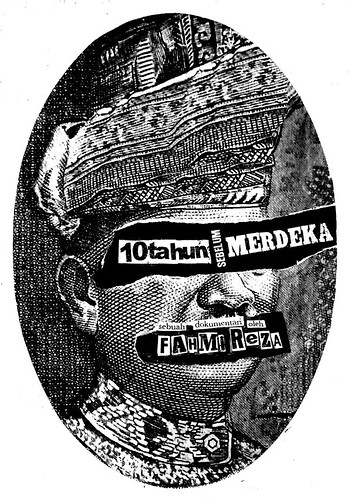FILLING IN THE BLANKS OF HISTORY
by Koh Lay Chin
Film maker Fahmi Reza's documentary 'Sepuluh Tahun Sebelum Merdeka' has brought forth a lot of positive reaction from viewers and this has really spurred him on.
IT was a hot month for London, but all I wanted was one letter.
With the Free Burma protests, anti-war march and one mammoth postal strike all busting out around the same time, it felt trivial to be longing for just the mail.
I finally received one almost three weeks after I arrived, and I loved it like a winning lottery ticket.
The postal strike, which took place nationwide over workers’ grievances over pay and working practices, cost UK businesses hundreds of millions of pounds and irritated more than a few Britons.
The workers dealt Royal Mail a massive blow with rolling 24-hour strikes which started early October, and it was reported that there was a backlog of 200 million undelivered letters and parcels.
Unused to this appalling delay, I was frustrated. Unused to strikes, I was bewildered. How long can a strike last anyway? Don’t they know I need my student discount cards pronto? My British friends were more resigned to it, speaking about it with a mix of annoyance and acceptance. Generally, they hated the disruption, but understood the situation. After all, they’re not neophytes to pickets.
The tendency to strike is also commonplace in their neighbour, France, where its citizens are even more ardent and attuned to the concepts of protest and resistance. In the face of heavyweight strikes which debilitate the country, the French seem to be peeved and proud at the same time; their heritage demands nothing less.
Is the concept of labour strikes now so alien to Malaysians, who have not seen a major strike since 1962? Back then, 9,000 railway workers went on strike to demand the conversion of their daily rated wages to monthly salaries. This event lasted 22 days, eventually resulting in the government acceding to their wishes. Sure, there were other minor ones, but not many have registered in popular memory.
These days, the Malaysian trade union roar is gone, with what some call generally smooth industrial relations, with cases resolved through peaceful negotiation and dialogue.
But perhaps the memory of that roar holds an air of nostalgia for the older generation, and a mystique for the country’s youth. And perhaps it is this curiosity and mystique that has fuelled interest in young film maker Fahmi Reza’s documentary Sepuluh Tahun Sebelum Merdeka, which tells the controversial struggle for independence from British colonialism.
It won the “Most Outstanding Human Rights Film” at the Komas Freedom Film Fest last month, and was shown at various screenings nationwide to the delight of young and old alike.
The documentary, shot in a delightfully modern style but rich with historical detail, has introduced the word “hartal” to Malaysians who had no inkling of it before.
The hartal, described fondly by several octogenarians interviewed in Fahmi’s piece, was a mass protest in 1947 that involved a total shutdown of workplaces, offices and shops in Malaya and Singapore — the first political action that united all races and different groups.
Malay nationalist groups, middle-class English speakers, women, labour unions, Chinese Chambers of Commerce, Indian organisations and others took part.
Fahmi’s 35-minute visual compiles events leading to the hartal, mainly the realisation of an independent Malaya and the publication of a People’s Constitution drafted by Putera-AMJCA (Pusat Tenaga Rakyat-All Malaya Council of Joint Action), an alternative constitution to challenge the Federation Constitution.
There were plenty of write-ups in the media about Fahmi’s work, but it was the positive reaction of the crowds watching his piece that really spurred him on.
The documentary is now easily found online, after much public demand, and the 30-year-old history buff has been more than happy to provide more screenings.
I first saw the documentary last month, before I left for London, but unfortunately could not stay to watch the whole piece. By the time I finished watching it online some time later, there was a warm buzz about the piece and many friends were asking why we hadn’t know about the hartal until now.
Now, this is not to say young Malaysians who watch the documentary are likely to flip out at their employers, baying for blood, or stay away from work a la the French. In fact, it seemed less about the protest and more about the coming together of the different sectors of society that truly enthralled viewers.
In a nation that has been lamenting about youth apathy (such as the 4.5 million eligible to vote who have not registered), it’s reassuring that they have started taking an interest in history.
Isn’t it infinitely more heartening to know young Malaysians are trying to find out more about their country, than to obsess over Britney Spears’ latest indiscretion? Fahmi spent many years of dedicated research because of his zest and love for history.
Somehow my three-week grumbling for my mail seems a little embarrassing in comparison.
NST journalist Koh Lay Chin is on a master’s programme at the London School of Economics.
Sumber: Akhbar New Straits Times, 31 Oktober 2007
Rabu, Oktober 31, 2007
Artikel dari akhbar New Straits Times, 31 Okt 2007
Dicatat oleh
Fahmi Reza
di
3:06 PTG
![]()
Kategori: Liputan Media
Langgan:
Catat Ulasan (Atom)

Tiada ulasan:
Catat Ulasan